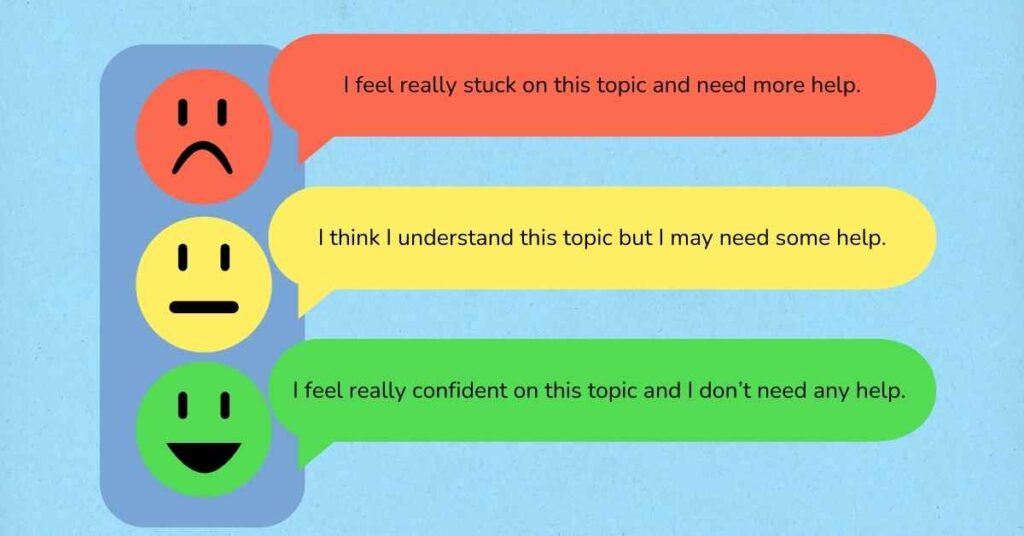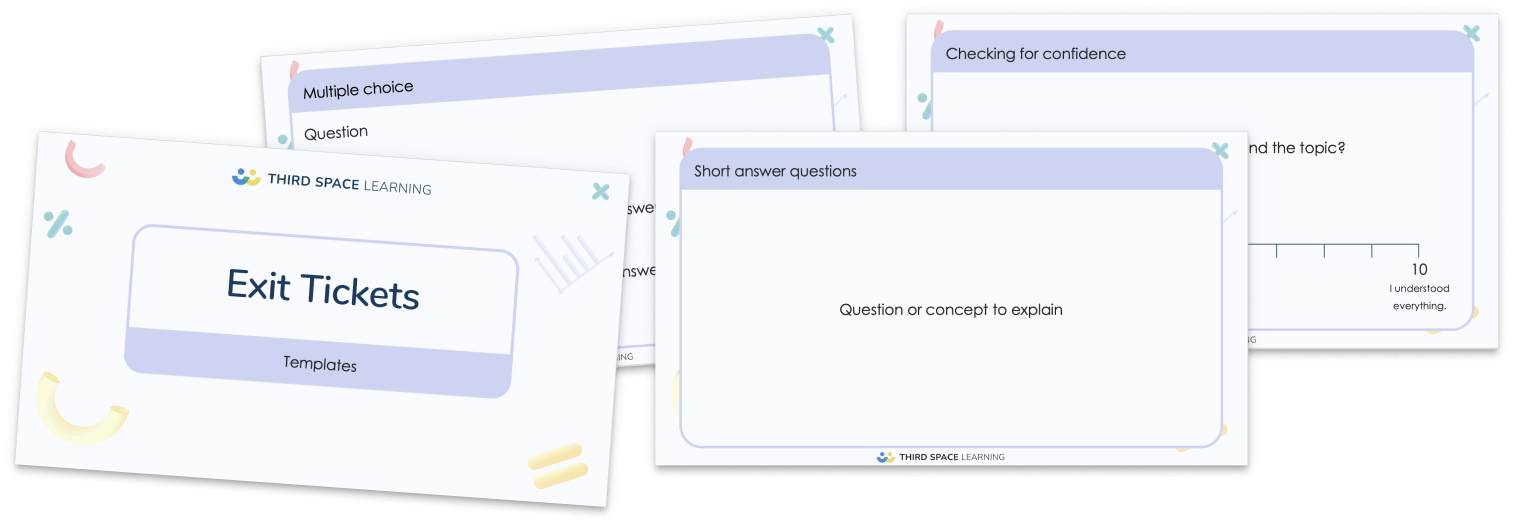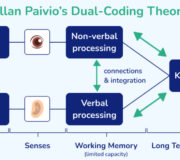How To Use Exit Tickets To Find Out What Your Students Have Learned [10 Templates Included]
Exit tickets are a valuable assessment tool for gauging student learning and progress. They are a great way for students to demonstrate their understanding at the end of a lesson or topic, providing valuable feedback to both the teacher and themselves.
In this blog, we will be looking at exit tickets, how they can be used most effectively, and the benefits of using them. You will also find examples of exit tickets and editable exit ticket templates to use in the classroom.
What is an exit ticket?
An exit ticket is a short informal assessment activity, typically given to students at the end of the lesson. The purpose of an exit ticket is to quickly assess students’ understanding of the objectives and key points. They provide immediate feedback to both the teacher and the student, enabling gaps in knowledge to be identified and addressed.
An example of an exit ticket is a piece of paper before the lesson ends, containing a few questions related to the lesson. The students complete these questions and hand them back to the teacher. The ticket may also contain a section for students to make note of how they found the questions, enabling teachers to quickly assess how each student has performed and see each student’s self-assessment of the task.
Exit tickets are also sometimes known as exit slips.
Exit Ticket Template With Examples
Download this free editable exit ticket template for each of the 10 most popular exit ticket rubrics. Quick, easy and effective assessment tool with no impact on workload
Download Free Now!How exit tickets fit within your assessment strategy
An exit ticket is a type of formative assessment: an informal assessment used by teachers to assess their students. This type of assessment differs from a summative assessment, which is usually a more formal test such as an end of a topic test.
Although both formative and summative assessments can vary depending on the context in which they are being used, formative assessment is widely recognised as a low-stakes form of testing. Teachers can use formative assessment to provide feedback to their students and inform their teaching.
See also: Assessment for Learning
For example, by using an exit ticket, teachers can quickly identify whether the whole class will need to revisit the concept, or whether individuals or small groups require extra support.

Meet Skye, the voice-based AI tutor making maths success possible for every student.
Built by teachers and maths experts, Skye uses the same pedagogy, curriculum and lesson structure as our traditional tutoring.
But, with more flexibility and a lower cost, schools can scale online maths tutoring to support every student who needs it.
Watch Skye in actionHow to use an exit ticket
Exit tickets are an excellent method to assess pupil progress and the level of understanding in any particular lesson. For the tickets to be effective, you should think about where they will fit into your lesson plans and how best to use them.
Here is a step-by-step guide on how to use exit tickets most effectively:
1. Plan ahead
Plan the day’s lesson as normal and identify the overarching objective you want to cover and assess. Create the exit ticket based on the objective, designing a problem or some questions in line with what your students have covered during the lesson.
2. Deliver the lesson
Deliver the lesson, ensuring your students have a good understanding of the objective and how they will know they have been successful.
3. Present the exit ticket
Towards the end of the lesson, present the exit ticket. Ensure your students understand that the purpose of the ticket is to assess their understanding of the lesson and identify any students who may need extra support.
Provide students with the exit ticket at the end of class. These can be paper slips, completed on mini whiteboards or completed digitally, if this is an option. The exit ticket could also take the form of whole-class hinge questions, either written or verbal. Students will complete the problem or questions on the exit ticket and may also self-assess their own understanding.
4. Review responses
Collect the student responses in – manually, verbally, or digitally (if the children have completed the tickets on a digital device). Review the tickets to check your students’ understanding and identify who requires additional support.
5. Provide feedback
Get your students to understand where support is needed, but also to receive recognition when the objective has been successfully achieved.
6. Use data to inform future planning
Exit tickets are an effective way of tracking pupil progress in primary schools and secondary schools. Use the assessment data from the tickets to determine the next steps – whole class recap, small group, or individual intervention. Keep track of the progress of the students, such as those who successfully achieve the objective and those who require additional support.
How to use exit tickets to adapt your teaching
Through analysis of the exit tickets, teachers can adapt their teaching to address the needs of their students. The information you gather can identify which students require support before moving on, while those who have fully understood the concept are able to move on without any additional support.
You can create exit tickets to assess your students’ level of understanding. Questions can be tailored to identify which students have achieved the objective, with a more complex question at the end to assess the depth of understanding.
Students who are working at a deeper level can be provided with more challenging questions based on the understanding demonstrated in the exit ticket. Students who are struggling, or those on track but with gaps in understanding, can be quickly identified and provided with small group or one-to-one intervention the next day.
At Third Space Learning, assessment is embedded in every online one-to-one maths lesson. At the start of each lesson, Skye, the AI maths tutor, assesses pupils’ knowledge of the topic they’ll be working on, adapting the lesson in real time to meet their learning needs.
Skye also monitors understanding throughout the session, adjusting hints and scaffolding as needed, evaluates each pupil’s grasp of the maths concept by the end of the lesson, and records how confident they are in their understanding.

When to use an exit ticket
Exit tickets are most commonly used at the end of a lesson to assess student learning. This provides you with a quick and simple method to assess your students’ understanding of the lesson and identify misconceptions. These can be quickly addressed, either at the start of the next lesson, or in an intervention session prior to the lesson.
Other times you can use exit tickets could be during a lesson, before transitioning onto the next activity, or before starting an independent activity. You can use the task to establish whether learners are ready to start a task on their own and for periodic check-ins throughout a lesson. They don’t need to be used every lesson. It is down to the teacher to decide when exit tickets would be most beneficial.
The benefits of exit tickets
- Immediate feedback: Exit tickets provide valuable feedback and help teachers to quickly monitor student progress, identifying which students have a good understanding of the material taught that lesson and which students may require additional support.
- Identifies common misconceptions: These may be misconceptions by individual students, a small group, or may also be a wider issue which needs to be addressed with the whole class. Once a misconception is identified, the teacher is able to put steps in place to address it and provide support to the children who need it.
- Adaptive teaching: The information teachers gauge from the exit tickets enables them to adapt their teaching based on the individual needs of the students.
- Promotes student reflection and metacognition: Exit tickets encourage metacognition and they allow students to reflect on their learning process. They prompt students to think about what they have learnt and what they may still find difficult, developing their metacognitive skills, affective domain, and independence.
- Low-stakes formative assessment tool: Exit tickets are a quick means of assessing, without the pressure that comes with more formal assessments. They gauge progress and areas of strengths and weakness in a relaxed way.
- Informs future lessons: Teachers are able to analyse exit tickets to determine the direction the next lesson takes and identify students who may benefit from additional support.
- Encourages accountability: Students who complete tickets can become more accountable, as they can focus on what they are learning and whether they have been successful.
- Time efficient: Exit tickets are quick to complete, and therefore a time-efficient way to establish the understanding of all students.
10 exit ticket ideas and examples to use in the classroom
Exit tickets can take various different forms. They can be recorded on paper or digitally. Here are some examples of exit tickets you can use in the classroom; for each of these we’ve include an example on the free downloadable exit ticket template.
1. Reflective questions
These encourage students to think about the lesson and how successful they have been. This can be through simple questions, such as: ‘What did I learn today?’, ‘What did I find most challenging?, and ‘What did I do to overcome the challenge?’
2. True or false
Get your students to decide if a statement is true or false, based on what they have learnt. For example: ‘17 is a prime number’.
3. Multiple choice
Give your students questions with multiple answers so they can identify the correct answer.
The n th of a sequence is given by an^{2} + bn where a and b are integers.
The 3rd term of the sequence is 3 .
The 6th term of the sequence is 42 .
Find the 5th term of the sequence.
Which is the correct answer?
A) 29
B) 5
C) 25
D) 18
Answer
C) 25
(4 marks)
Example multiple choice question
4. Short answer questions
Ask your students to explain a brief written response to a question or explain a concept in their own words. For example: ‘Describe how to find the area of a compound shape’.
5. Checking for confidence
Ask your students to reflect on the lesson and how confident they now feel. Questions such as ‘how well did you understand the topic?’ can be answered on a scale of 1-10. Confidence can also be measured using emojis (if the exit ticket is digital) or a traffic light system where students assess their confidence using red, amber, and green.

6. Complete the blanks
Provide students with a sentence containing missing variables or numbers. Children need to fill in the blanks. For example: ‘The formula for calculating the area of a triangle is \frac{1}{2} base x _________.
7. Identifying errors
Provide students with a question or problem which contains errors and ask them to identify and correct the mistakes.
8. Short response
Ask students to describe a concept or a method in their own words. For example, ‘To simplify a fraction, I need to find the highest common factor of both the numerator and denominator and divide both by this factor’.
9. Matching
Provide students with a list of statements to match with the correct answer. For example, a list of shape names and a list of the number of sides for students to match up.
10. Problem solving
Present a problem for children to solve which is based on the learning that has taken place that day.
How to present exit tickets
Exit tickets can be presented to your students in various formats, depending on the resources and technology available. Here are some physical and digital examples of the different formats they can be presented to students:
- Paper-based exit tickets: The tickets can be printed on paper slips to be given to your students. You can easily print our downloadable exit ticket templates for use in the classroom. Exit tickets could also be in the form of sticky notes for your students to stick their responses to a board or wall.
- Digital exit tickets: Online platforms such as Google Forms can be used if your students have access to tablets or computers. Questions can also be sent through messaging apps for students to reply with their responses.
- Verbal exit tickets: Students can be asked to respond verbally. This works particularly well for younger students. This can either be in small groups or as a whole class together.
- Physical manipulatives/visual representations: In maths, children can be asked to represent a concept using concrete resources, maths manipulatives, or drawings to demonstrate their understanding.
Tips for teachers when using exit tickets
- Make a direct link to the lesson objective: Ensure that the ticket questions or task focuses on the particular skill your students need to know for that lesson.
- Set shorter questions/multiple choice: Exit tickets using this style of question makes the data more manageable and enables teachers to collect data more immediately.
- Set clear expectations: Ensure that students have a good understanding of what is expected of them and how they should be responding. Also make sure they understand that the exit tickets are a diagnostic assessment tool to help students as well as teachers.
- Make it interactive and engaging: A good exit ticket should be engaging. If the children see the task as something which is fun to complete, they are much more likely to be focused. If the task is dull and repetitive, the teacher won’t necessarily get the best out of the children.
- Respond to data: For the exit tickets to have an impact, data should be used to inform future lessons. The data can be analysed to identify patterns and areas where students may require additional support.
- Use a range of question types: Include a range of different questions such as: short answer, multiple choice, problem-solving, and reflective questions. These will enable you to test different areas of mathematical understanding and reduce the risk of the task becoming monotonous to your students.
- Provide feedback: This could be whole class feedback, or to a group or individual. It is imperative to ensure your students are learning from the task and understand where their strengths and weaknesses are.
- Use exit tickets regularly: Regular use of exit tickets enables you to monitor progress over time and ensure that the following lessons are adapted in response to the data.
- Share your use as part of professional development: Once exit tickets are part of your assessment toolkit share your ideas and favourite examples with colleagues – you’ll likely both pick up something new.
Looking for more information about assessment?
- 19 Formative Assessment Examples To Enhance Teaching and Learning
- What NEW KS1 Assessment Frameworks Mean For KS2 [Maths]
- Primary School Grades Explained
- Differentiation In Teaching
An exit ticket is a formative assessment tool, used for evaluating students’ understanding at the end of a lesson or unit of work. They are short tasks for the student to complete, which enables them to demonstrate what they have learnt during the lesson or unit of work.
There are a range of different names people use as an alternative to exit tickets including: exit slips, closing tickets, quick checks, lesson checkouts, reflection cards, and wrap-up tasks.
Exit tickets should be used regularly, but the teacher needs to plan these ahead to ensure they are relevant and appropriate. They could be used daily, multiple times a week, or weekly. They could also be used after key topics and as periodic check-ins.
DO YOU HAVE STUDENTS WHO NEED MORE SUPPORT IN MATHS?
Skye – our AI maths tutor built by teachers – gives students personalised one-to-one lessons that address learning gaps and build confidence.
Since 2013 we’ve taught over 2 million hours of maths lessons to more than 170,000 students to help them become fluent, able mathematicians.
Explore our AI maths tutoring or find out about maths intervention programmes for your school.







